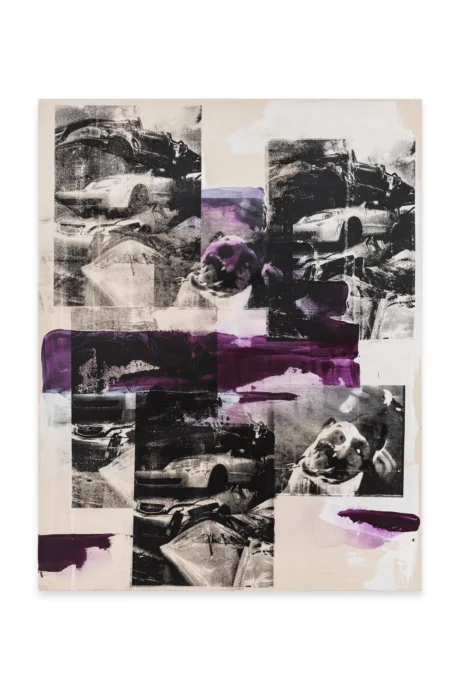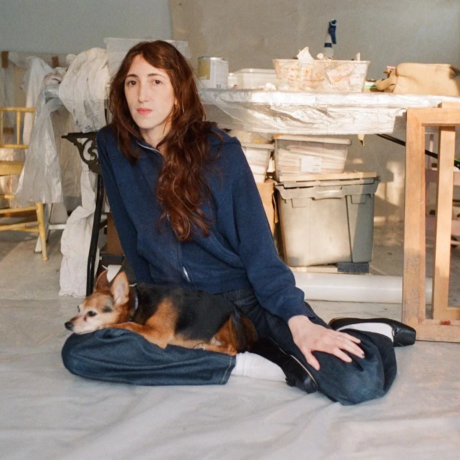
Elephant writer, Eloise Hendy, speaks with Naomi Rincón Gallardo about her punky, queer musical ‘Sonnet of Vermin.’ Currently on display at the Hayward Gallery until September 1st.
A frog, a scorpion, a snake, and a bat with luminous green and pink wings emerge from the tendrils of a woman’s hair. Her disembodied head protrudes from dry earth, and her dark locks splay out across rubble and parched weeds. As the creatures flit around her, her face cracks into a wild grin, eyes widened to their whites. She runs her tongue over her teeth, as if ready to devour. Welcome to Naomi Rincón Gallardo’s Sonnet of Vermin, which is currently being shown at the Hayward Gallery, in the Mexican artist’s first solo exhibition in London.
Rincón Gallardo’s film defies categories. It is a punky, queer musical that adopts DIY aesthetics and Mesoamerican mythology to tell an apocalyptic tale about climate breakdown and species collapse. It’s also a raucous party, a ghost story, a dreamscape, and a furious response to the violence of Mexico’s ‘war on drugs’, where radio antennas speak in voices from the dead and groping arms burst through arid topsoil.
The four creatures that materialise from knots of hair are our vermin protagonists – “unwanted” creatures that perform a series of surreal musical numbers. The frog joins a chorus of child frogs, who hop about a pool of water. “The sun was never so hot,” the frogs sing. “The soil never so parched. The waters never so foul. Our lives so trashed”. This is not a funeral dirge for a dying earth though, but a fervent spectacle. “We absorb industrial waste,” the frogs chant, their painted faces and amphibian headgear glittering. These hybrid creatures have developed a taste for pesticides and agrochemicals. “Give me lead, cadmium, I’m thirsty,” they cry, drinking dirty water through red plastic straws like long tongues. The end is nigh, Rincón Gallardo seems to pronounce, but she also offers an opportunity for survival; for resistance. “We crack the pavement like stubborn weeds,” the scorpion sings. “We become virulent in solidarity”.
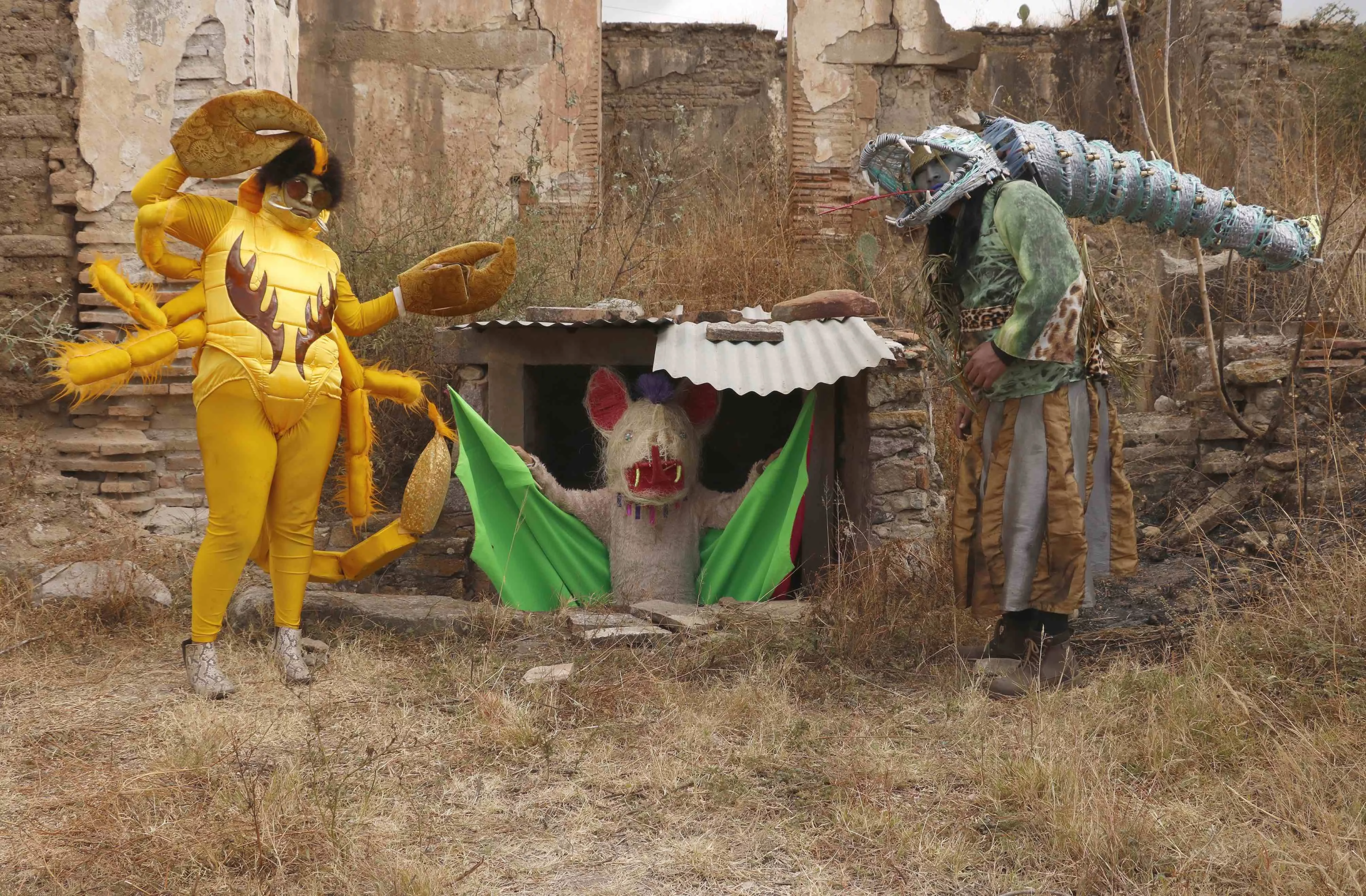
“I live in Oaxaca in Mexico,” Rincón Gallardo tells me the day the Hayward exhibition opens. “There was a moment where there was a crisis of garbage recollection. And the solution they found temporarily to deal with all that – the amount of garbage and toxic residues – was to throw them in the river.” This was the starting point for Sonnet of Vermin, Rincón Gallardo says, especially for the “children amphibians who are demanding to have another dose of toxins. Instead of reclaiming a future, what they want is just to continue dancing and playing among the toxic ruins”. Yet, the film also connected with something that she has been working on for the last decade, which, she tells me, “has to do with which stories can we tell from a territory that is overpopulated with premature death”. In this “moment of necropolitics and constant non-official wars in the Mexican territory,” as Rincón Gallardo puts it, her work has repeatedly spun around endurance, and collective joy. “My work revolves around how to create forms of meaningful relationality, to find other forms of survival,” she says. “But beyond survival to find ways in which you can still aim for a pleasurable life.” Together, these concerns with violence against human and non-human alike, and how to seek pleasure among the ruins materialised into Sonnet of Vermin, where “different vermin or unwanted creatures get together to create a sort of subaltern solidarity.”
When she started working on the film, “it was right after COVID time”. So, naturally, the first “unwanted creature” she devised was the bat – a symbol of darkness that Rincón Gallardo studs with disco light eyes. There’s the group of children frogs, and “there’s also a snake who is shedding [it’s] skin,” Rincón Gallardo says. “The snake in Mesoamerica is a very important symbol of transformation because of the capacity of getting rid of that skin, and rebirth,” she notes. “So the snake is announcing this transformation of cycles.” There’s also an alligator. “The one who devours everything,” Rincón Gallardo nods. “That’s inspired by a Mesoamerican figure called Cipactli, who is an alligator that has this ruffled skin that represents the surface of the earth,” she adds. “It’s basically the one who takes all living beings to soil and to subsoil in order to create new life”.
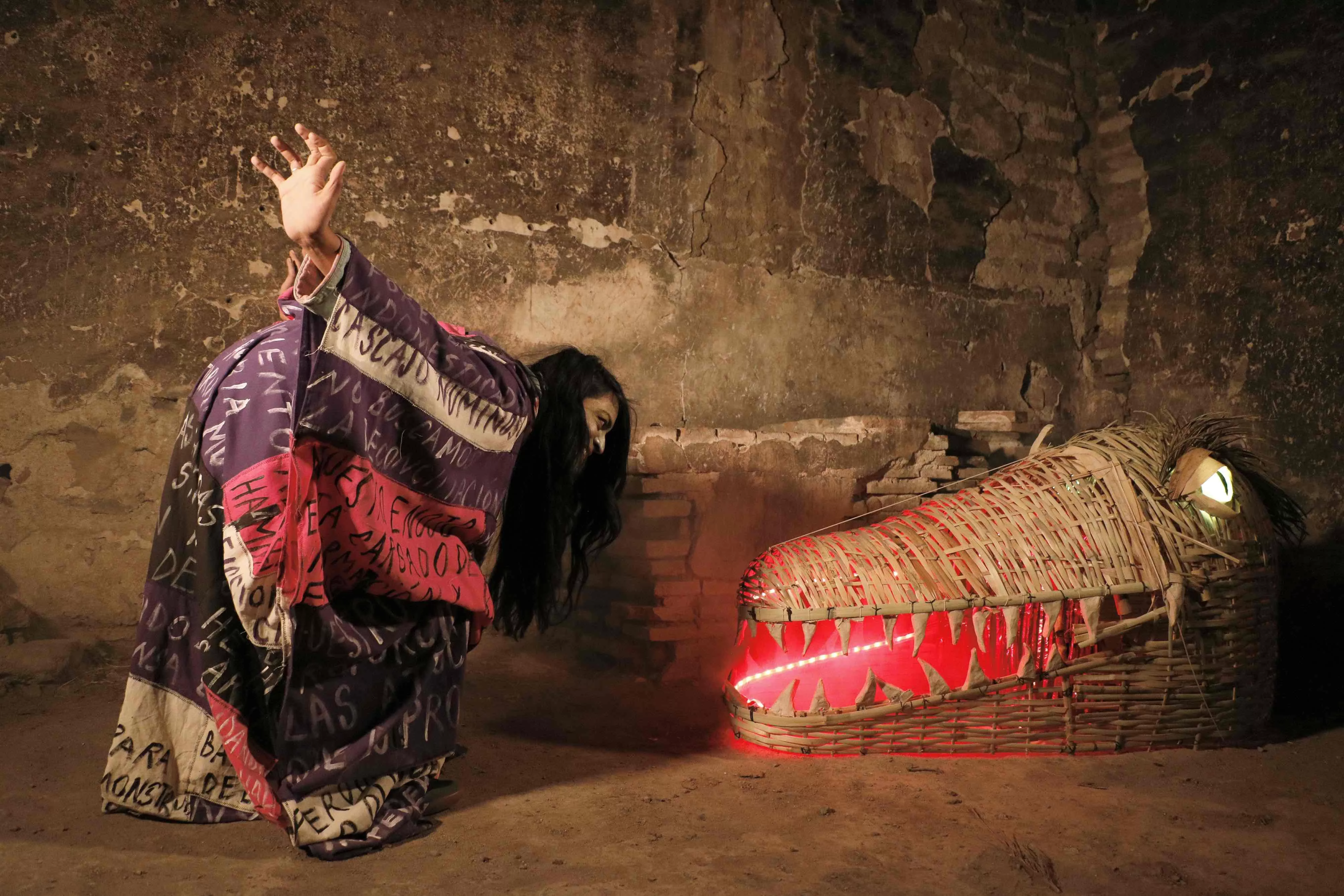

Rincón Gallardo does not just wield Mesoamerican myths to conjure cycles of death and rebirth though, she also uses mythology to speak directly to contemporary Mexican politics. There’s a radio character, for instance, which is also a funerary bundle. “That’s inspired by a funerary Mesoamerican practice before colonial times where people would wrap the dead before they would get rid of the body,” Rincón Gallardo tells me. “In the video, there’s a moment when there’s a hand who is synthesising with the bundle,” she adds, “and what we can hear is lots of interrupted speeches from people who’ve been recently killed in Mexico.” The radio becomes a communication device to commune with the dead, “who want to fight for an afterlife because their life was violently interrupted.” Something similar is at work when groping arms reach up out of the earth, “which,” Rincón Gallardo says, “is a very well known trope in horror films, right?” In Sonnet of Vermin, these figures act as “reminders that there was someone who was killed unjustly.”
This is a thread that runs throughout Rincón Gallardo’s work. Indeed, the disembodied arms appear in three of her film works, Verses of Filth, Sonnet of Vermin, and Eclipse, which were shown as a trilogy at Artes Mundi last autumn. “They are all connected with ideas of sacrifice, object characters that are reclaiming for a queer pleasure of relationality,” Rincón Gallardo says, “and they are all connected with animals that were somehow related to the Mesoamerican underworld.” In her 2021 film, Verses of Filth, for instance, there is a group of vultures. “Vultures in Mesoamerican philosophy were considered to be sacred animals for their capacity to connect the sky, the earth, and the underworld,” Rincón Gallardo tells me. “They would enter their head into the corpse, and they would be entering the underworld. But they’re also considered to be the great purifiers,” she adds, “because they cleanse the stench of the world.”
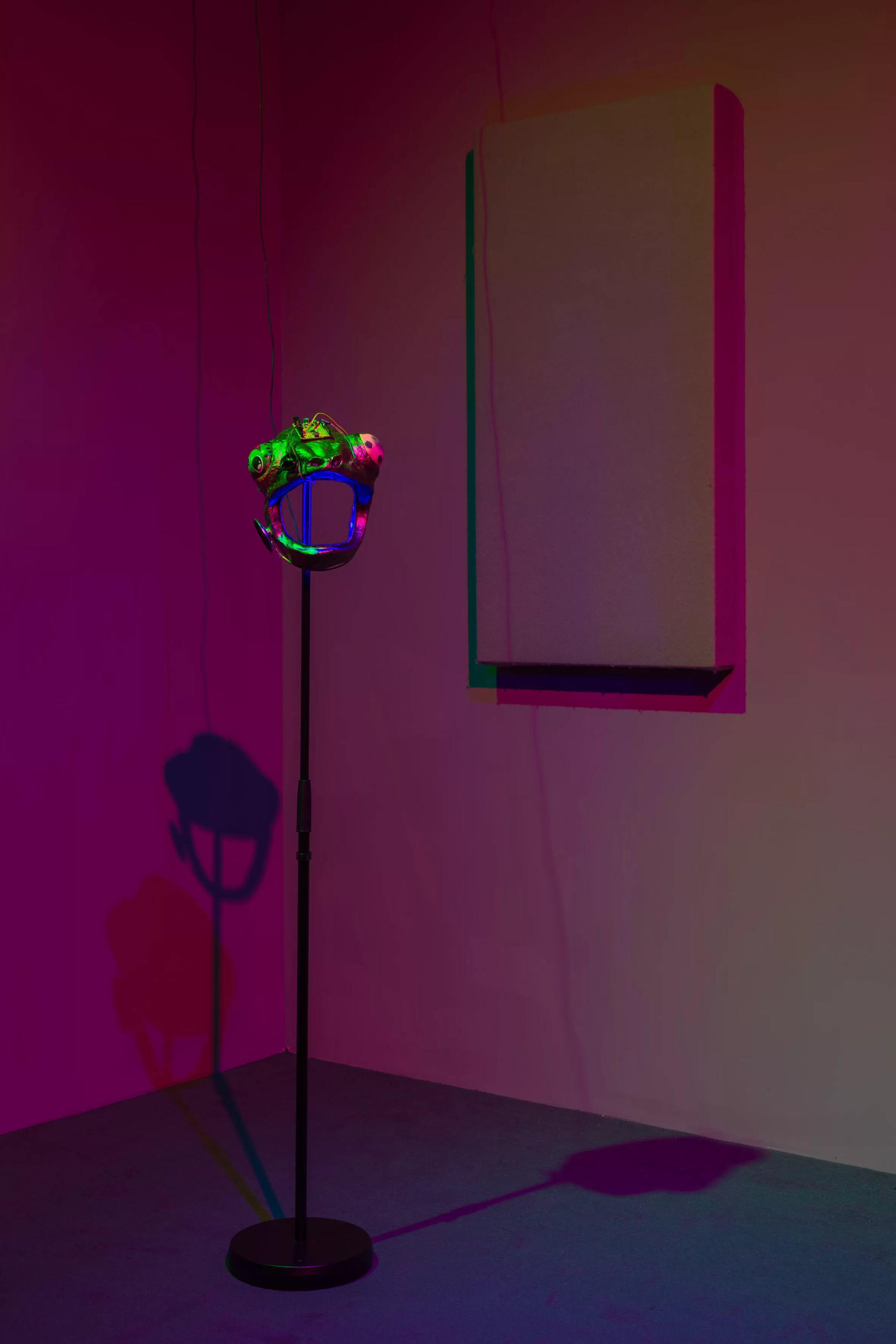
Together, the trilogy has been dubbed the Tzitzimime Trilogy. “The Tzitzimime are skeletal figures that appear in painted colonial manuscripts from the 16th century in central Mexico,” Rincón Gallardo explains. “[They] were supposed to appear and come down to the earth in moments of cosmic danger. For instance in moments of eclipse,” she notes, “when people would fear that night would prevail forever.” Eclipses were considered an event that were, Rincón Gallardo puts it, “absolutely dangerous,” because the moon would “devour” the sun. Again though, Rincón Gallardo pulls the myth into the here and now: “I think we’re in a perfect moment globally of cosmic danger, for the Tzitzimime’s descent.”
Yet, for all this apocalypse talk, Rincón Gallardo is quick to add that she was drawn to the Tzitzimime because they also represent a kind of queer play. “Their gender is sort of ambiguous,” she says. “It’s ambivalent. They are female, but they have snakes running from the legs, which is a phallic symbol. So they are female and male.” This gestures to something she finds “super inspiring” in Mesoamerican philosophies. “They make a connection between some ideas related to queerness,” she says, “because there’s a challenge to any kind of binary system of classification. There’s also a decolonial possibility of challenging or dismantling this modern colonial way of ordering things,” she adds. “I think they really challenge this binary opposition between the animal and the human, and between life and death.”
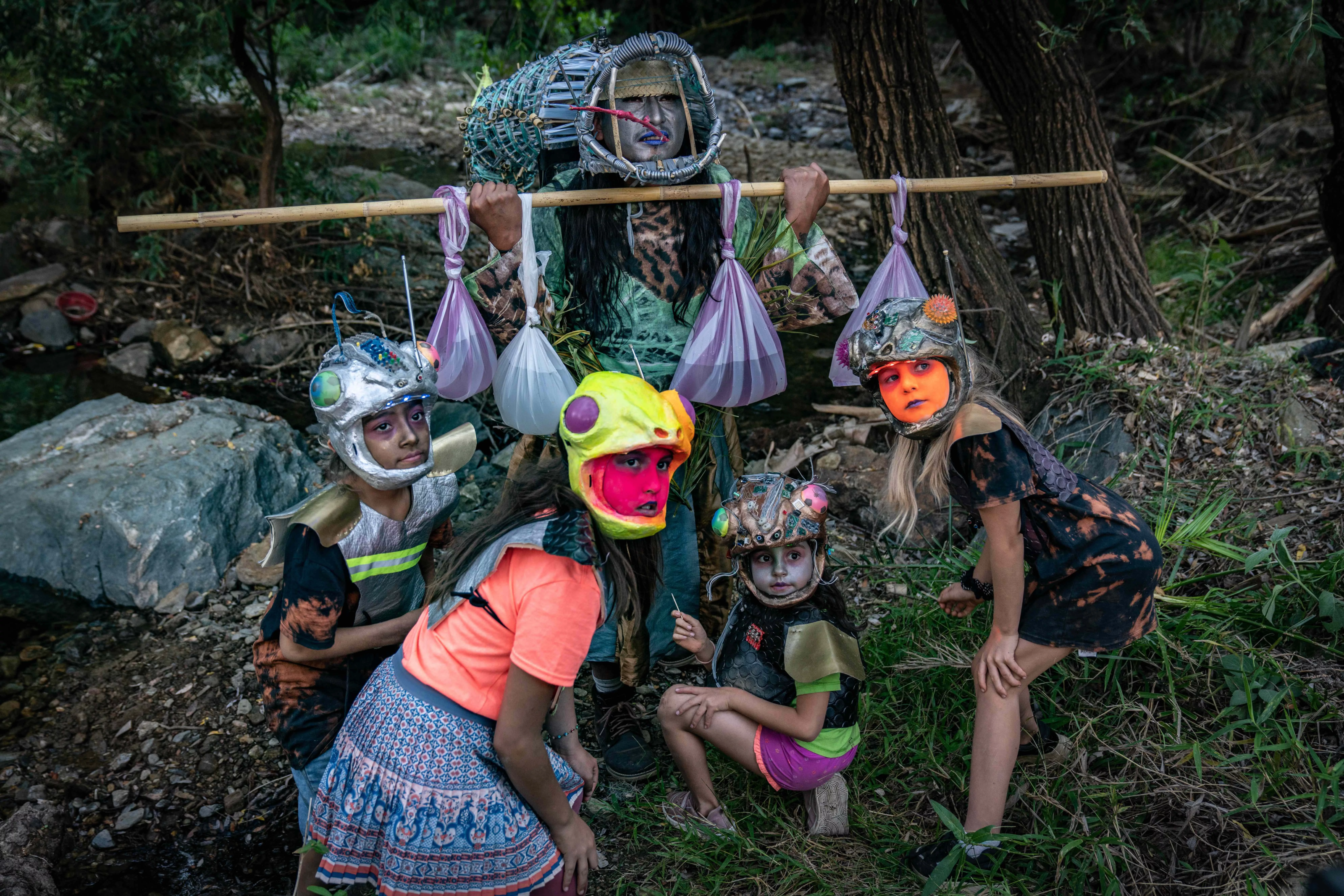
In the past, Rincón Gallardo has said she “bastardises” mythology in her work. “There is some sort of revolt against patriarchy” in that idea, she tells me. “There’s something illegitimate. And there’s something also impure, right?” Yet, as with her vulture figures, here too impurity and purification seem perversely entwined – the urge to “bastardise” myth also a way to honour their inherent multiplicity. “I find in myths these models for looking at life differently,” Rincón Gallardo says thoughtfully. “Specifically with Mesoamerican myths there’s all these possibilities to understand temporality in a non-linear way.” She likes to think the “myths are spirals of time that overlap,” with no end point. “There’s a very nice aphorism that’s not Mexican, but it’s from the Aymara region in South America,” she muses, “that says we walk with the past in front of us, for the past is the only thing we can see.”
These kinds of topsy-turvy inversions are typical of Rincón Gallardo’s art. “That’s the way in which I engage with myths,” she says. “There’s a way that I address them in a non-linear way, then there’s revolt against patriarchy, and then there is the possibility to catch up with ancient accounts of thinking differently,” she stresses. “I think they give an account of a different way of understanding life and death and understanding the mutuality between different entities – human, animal, cosmic, terrestrial”.
At the heart of all of this, is a reverence for connection and collaboration – for collective ritual and belonging. “There’s a different kind of knowledge that is not necessarily rational, or instrumental,” Rincón Gallardo suggests, “that is a knowledge that is attached to the body. The way you bond, the way you cook, the way you eat together with others, the way you dance, the way you celebrate… I think all that is connected with reclaiming something beyond survival, in spite of the harshness of the circumstances.”
As she says this, I can’t help but think of one of Sonnet of Vermin’s filming locations – a Hacienda that was built on top of a pre-colonial era tomb. “It’s in ruins now,” Rincón Gallardo says. “So I wanted to have this reminder that the lesson now is how to live among the ruins. How to live and enjoy and create all these narratives, all these connections in a place that’s damaged, that is not idyllic whatsoever. It’s damaged, and you still fight or try to organise collectively. So you have a dignifying, plentiful, pleasurable life”. In other words, this may be a time of cosmic danger, but the “unwanted creatures” can still dance. As Rincón Gallardo says, “people may find ways of generosity in spite of the precarity.”
Written by Eloise Hendy
Naomi Rincón Gallardo’s ‘Sonnet of Vermin’ is on display at the Hayward Gallery until 1 September.
find out more



